Delaware the 5th most bicycle-friendly state in America? “I figured either LAB had gone crazy or else I had.”
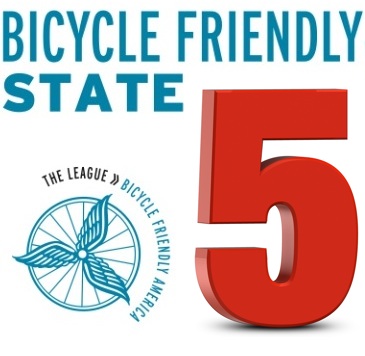
“When I first saw the headline, I figured either LAB had gone crazy or else I had.” – recent comment by Bike Delaware reader
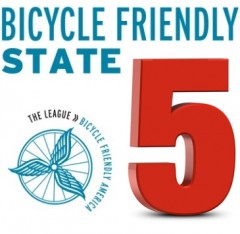 Just a few years ago, Delaware’s “Bicycle Friendly State” ranking by the League of American Bicyclists (LAB) was somewhere in the 30s among the 50 states. In 2011, we were ranked 18th. Then, last year, we cracked the top 10 and started eyeing the #1 spot. (In fact, we said getting to #1 was the #1 reason to join Bike Delaware.)
Just a few years ago, Delaware’s “Bicycle Friendly State” ranking by the League of American Bicyclists (LAB) was somewhere in the 30s among the 50 states. In 2011, we were ranked 18th. Then, last year, we cracked the top 10 and started eyeing the #1 spot. (In fact, we said getting to #1 was the #1 reason to join Bike Delaware.)
This year the LAB announced its new Bicycle Friendly State rankings on May 1. Delaware had not only managed to hold on to its #10 ranking, we had shot up to #5! And the only four states ranked higher were all western states, making Delaware the most bicycle-friendly state east of the Mississippi River.
When a reader recently commented that “when I first saw the headline, I figured either LAB had gone crazy or else I had“, we could understand.
So how do we explain our rapid ascent in the LAB rankings? Rather than just making up an answer ourselves, we thought it would just be easier to ask LAB. So we did.
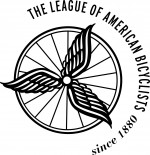 According to Nicole Wynand, the manager of LAB’s Bicycle Friendly State program,
According to Nicole Wynand, the manager of LAB’s Bicycle Friendly State program,
“Governor Markell’s vision to make Delaware one of the most walkable and bikable states in America has transformed the way transportation policy is developed and implemented in the First State. Delaware’s impressive financial commitment to cycling, the proposed Trails and Pathways Plan, the recent 3-ft passing and vulnerable road user laws, and the strong support by advocacy groups and citizens has catapulted Delaware past great states for cycling like Massachusetts and Wisconsin. We see a lot of potential in Delaware to move up even further in the coming years.”
So there it is. It’s actually a simple explanation:
- Two past legislative successes
- The First State Trails and Pathways Plan
- Money for cycling improvements
- Governor’s Markell’s vision
- Strong support by advocacy groups
In terms of how we keep our new #5 ranking (or improve it), we have to execute on these promises. Everything except the two legislative successes is contingent on continued funding for cycling improvements. Delaware’s Bicycle Friendly State “report card” just underlines that. And so does the same reader I quoted at the top of this article:
“Thanks for posting the actual report card. It explains how Delaware can rate so high in spite of my Delaware cycling experience being much worse than when I rode regularly in the South Bronx and other parts of New York City in the 1990s. When I first saw the headline, I figured either LAB had gone crazy or else I had. But none of the rating items is actually a measure of cycling *experience* or real conditions on the ground, so the divergence is perfectly understandable. And I realize that I live in a particularly bike unfriendly part of the state. Anyway, keep up the good work Bike Delaware! Change is slow.”
If Bike Delaware had $10,000 laying around that we had to spend tomorrow on a public service announcement, it wouldn’t be for a giant “Share the Road” billboard. But it might be for a giant billboard that said “CHANGE IS SLOW”. Probably the most difficult single idea we strive to get out to the public AND to decision-makers is just that: Change is slow. The reason that change is slow is because the primary variable that controls the quantity and quality of bicycling in Delaware is not a regulation or a sign or even public or cultural attitudes. The primary issue is the bicycle-friendliness of the physical built environment. And that’s not something we (or even Governor Markell) can snap our fingers overnight to change.
But just because the magnitude of the problem is huge doesn’t mean we can’t make Delaware more bicycle-friendly than it is right now. Indeed, every single year we have a huge opportunity in Delaware to do just that. How huge do you want? Is $400 million huge enough for you? Where does that number come from? That’s the size of DelDOT’s annual capital budget for transportation “improvements”. $400 million. Every single year.
Here are our choices. We can take every last penny of that $400 million and spend it on more / larger / better roads. Or we can just spend most of it on more / larger / better roads and some of it on other transportation modes (including cycling). Bike Delaware is fighting for the latter. The vote by the critical committee of the Delaware General Assembly on whether any of next year’s $400 million for transportation improvements will go to Bike and Pedestrian Improvements is within the next 4 weeks. Be sure to read www.bikede.org every day for the next 4 weeks to keep abreast of the latest in this fight, and for information about how you can make your voice heard for building a more walkable and bikeable Delaware.
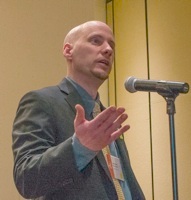
James Wilson is the executive director of Bike Delaware.
RELATED:
• Will the Delaware General Assembly Vote For Bike and Pedestrian Improvements This Year?
• Reason #1: Because we can make Delaware the most bicycle-friendly state in America





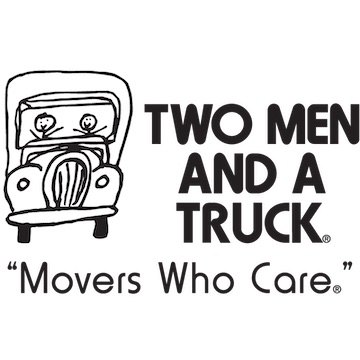
20 Responses
Bike Delaware is not fighting to get DelDOT to spend money to help transportational cyclists. In fact, James Wilson is doing all he can behind the scenes and behind closed doors to ensure that no money is spent to benefit me and cyclists like me. Even the public face of Bike Delaware is encouraging spending which will help recreational cycling but will not help Delaware’s mode share. The First State Trails and Pathways will undoubtedly increase bike trips but is not likely to decrease car trips. This is why I can’t consider supporting Bike Delaware in any way.
Here is how, in reality, the LAB does its rankings. I used to think that it was an independent information-gathering process and that the rankings were very meaningful. But now I know that they tend to pick one advocacy organization, and essentially parrot what that organization tells them. Therefore a state’s ranking has meaning in proportion to the honesty, integrity, etc. of the organization when the LAB has chosen one to rely on. And so, my new view is that, of the 10 states with top rankings, probably 3-6 of them are the states with the 3-6 most convincingly deceptive advocacy organizations.
My last comment was definitely reliant on speculation for its conclusion, although I feel it is rather likely. On a more sober note, I feel that the LAB should rank on what is a reality now, not on potentialities such as money in the budget which hasn’t been spent yet, having a bike-friendly governor, and promises made. Mode share, not building things which we promise will increase mode share.
Those of us on the ground, who actually bike the roads, know that there has not yet been a transformation in the way transportation policy is developed and implemented in the First State. Again, that is a promise that has not yet produced results for me and those like me who are actually out there cycling the roads. A sign here and a sharrow there cannot fairly be called a transformation. We on the ground know that the majority of projects are still not showing transformational implementation of a good complete streets vision. This is an excellent example of the LAB believing a statement made by its trusted advocacy group, rather than actually verifying its truth.
Very well put, DSA. I have never felt for a minute that Bike De represents the interests pf transportation bicyclists. Everything is this grand delusion about bike paths. While I think they have their place in the transportation system, ultimately, it’s the road that gets you there. No way around it!
They did at one time, up to a point. There is/was a push to retrofit right turn-only lanes as shared bike lanes. This will be a major Bike DE success if it comes to fruition. While a major component and not to be taken lightly, on-road infrastructure is a big piece of the advocacy pie (as seen on any full service advocacy org’s “about us” page). But it is one piece, one piece only. By choosing not to work with other orgs who take on a more all-encompassing approach, they are marginalizing themselves and their potential to really grow, and maybe one day reach full potential like many of their counterparts (i.e. the Bicycle Coalition of Maine).
Correction:
By virtue of being out there on the ground, we can’t see how policy is developed. But we can see how it is implemented.
Here’s a more complete history. Back in 2008, Delaware ranked in the low 30s-I believe 31. Our ranking shot up around 20 points in 2009 to 11th place, in good part due to the Complete Streets policy (creation, as it was not yet implemented) and the first bike summit (a joint effort by representatives from WILMAPCO, Dover/Kent MPO, DelDOT, Delaware Bicycle Council, Bike Delaware, Parks and Recreation, WCBC, Sussex Cyclists and others). In 2010, we dropped down to 18th, then back up to 10th in 2011. This year we are 5th, as mentioned in good part due to the progress we’ve made but also the hope that good intentions will translate into a more bike friendly state. Ensuring that good intentions translate to a bike friendly environment is definitely possible, but it will not be easy. Over the years, numerous agencies worked to build a foundation. Further progress was made once we had a bike friendly governor who initiated Complete Streets and the First State Trails and Pathways Plan. In addition to funding, legislation and infrastructure, we have made inroads in education, enforcement and encouragement. But we have a long ways to go. Funding is necessary but it alone won’t do it. First, we have to ensure that whatever funding we receive is put to best use. Certainly, we should consider recreational opportunities since they impact quality of life and health. We also need to encourage more people to use their bikes for transportation, which will help our world in so many ways. That is perhaps the most difficult challenge since it is impacted by so many factors, including attitudes, knowledge, infrastructure and land use. In terms of infrastructure, we need to make best use of the facilities that already exist including our roads, since this is the quickest, cheapest, and in many cases, the only practical solution. It is important to create networks that include viable, best practice facilities on a combination of arterial roads, low-stress and neighborhood roads, and trails in order to allow people to travel from their homes to destinations like work and shopping and school. It is unrealistic to think that we can create networks with only one type of facility due to the hostile nature of some roads, the lack of land to construct trails, the length of time it will take to create trails and similar facilities, and the large amount of money needed in some cases. We need many tools in our toolbox. Maybe someday we will create a utopia. But for now, we should work on the short term needs as well as the long term goals. We should correct deficiencies, often minor, that create barriers to usable routes. In this way, for a relatively low cost and within a short period of time, we can create usable facilities that the majority of cyclists–from road warriors to the timid– will find adequate, if not ideal. In addition, the way we conceive of and build our environment needs to change to accommodate a bigger picture that makes mass transit, walking and biking feasible, safe and convenient. Attitude is truly critical as well. A car culture combined with exaggerated fears and numerous misunderstandings is a serious barrier. We need the cyclists who are currently on the roads to serve as role models and show other interested people that it is both fun and feasible to bike for transportation. Education as well allows people to share the road. And enforcement of our laws is critical. Only when people take driving seriously, whether by motor vehicle or by bike, will we be able to make transportation safe and comfortable. All transportation. Progress is slow. It is a nuts and bolts, one foot in front of the other approach coupled with both a realistic vision and visionary goals, that will allow us to achieve a truly bike friendly state. You know what, though? Change is slow, but sometimes after years of establishing a foundation, it takes off and moves far more quickly. It’s more exponential than linear.
Rotten land use over many years should be enough to convince anyone that trails and pathways are only part of the solution. A small part. There just isn’t the right of way readily available, and even if there was, we should carefully examine the merits of each, so as not to add more impermeable surface to an already asphalt jungle. If the railroads were the least bit cooperative, we might have a few major spines to make valuable connections (i.e. Wilm. – Newark). But that’s not reality – in fact, they’re downright hostile to the idea! So anything of the sort is decades (and other administrations/priorities) away – if ever. When folks ask what a realistic timeline is for such projects, I usually refer to the Pomeroy Trail, which took 10 years to build – and that had its right of way intact.
Bike Delaware could be a much more effective advocacy org for today by going after the low hanging fruit – things that can be done with relative little money down yet have far reaching benefits, as you describe above. The Sharrow implementation in Newark is a great example, and might have happened sooner had Bike DE been actively supporting road advocacy and cooperating with other stakeholders.
While Ts & Ps are a great investment, and Bike DE’s leadership has done a superb job promoting it, folks want to ride their bike safely now. The only way to do that is through retrofit of our current transportation system. There is no avoiding that in any case, even in Copenhagen.
All true. And you have a point about impermeable surface. We have plenty of that already in Delaware, and you need only consider the extreme flooding that has occurred in recent years to get an idea about what overdevelopment of all kinds does. So we should pursue trails, but placement of facilities needs to be carefully considered. The railroads should wake up and cooperate. They appear to be ensconced in the 19th century when there was plenty of open space and we were expanding into it without a care about the native populations or the future.
I need to correct my timeline slightly. Delaware’s ranking were as follows:
31 in 2008
9 in 2009
10 in 2010
18 in 2011
10 in 2012
5 in 2013
I stand by the reasons given for the initial jump of 22 points and the rest of what I wrote. But I didn’t want to leave this inaccuracy in the comments.
I am a full time cycling and public transportation user in Delaware. From that perspective I agree there is a long way to go within Delaware, surrounding states, and the nation on alternatives to cars for transportation. No doubt.
That said there are so many facets to being cycling friendly as Amy points out. This includes the willingness to be open to conversation, funding, rule changes, etc. This is something that Delaware truly has over other states. It is possible to have solid meaning full conversations with cabinet level positions in the government.
As for where Bike DE’s focus is? Well that is tricky. There are about 4-5 active volunteers and a full time executive director. The volunteers due to day jobs and other commitments can normally only spend 6 or so hours per month. Therefore Bike DE needs to be very careful about where to focus its energy.
The two things we can do most to transfer Delaware permanently is to one focus on getting more and more people on bicycles and talking about bicycles. This type of ground swell will get more grass roots people out to city council meetings, talking to legislators, etc.
The second thing we can do is help educate the state’s key decision makers on the subject and create an environment that is ripe for quicker change as the vocal public increases in numbers and decibels.
Focusing on fixing a specific road or intersection is helpful. Each one of these items will fix a problem and will help a hand full of cyclists, but that is time consuming and doesn’t have a huge payback. It typically helps a minority of cyclists using a particular facility. In order to get the conversation up we need to focus on the masses.
The masses are not like us road warriors out there today. The masses aren’t riding their bikes today and aren’t the ones who will go riding up Kirkwood highway even if there is a bike lane there. This is why the focus Bike DE has today.
As for working with other organizations? Bike DE has very close relationships with many other organizations in the state of Delaware. This includes several health organizations, Delaware Greenways, Delaware Bicycle Council, several sporting clubs including sussex outdoors, white clay bike club and sussex cyclists and many more. This type of change can not happen without widespread support.
Are there things that Bike DE could be doing better? Yes. No doubt. If you have opinions on what those are and how we can implement those we would be happy to hear the constructive criticism and a recommendation on strategy. Better yet we’d love to have you join us and implement your suggestions.
That said here is to making Delaware a future cycling magnent. One that is a magnent for transportation cycling, destination cycling, and cycling as a choice. As a previous member Frank once pointed out, when talking about the C&O canal, cycling brings wealth to the surrounding communities. It took those communities around the C&O canal several decades to fully realize this. With the cycling community’s constant and steady push our communities will also realize this. This path will be long and with its ups and downs, but it will be ultimately worth it.
Bob, I think that what you say about the time which Bike DE board members have available to dedicate to their volunteer jobs is very important. In spite of this limited amount of time, so limited that they can’t manage to post minutes of their meetings, they took on the responsibility of creating an Executive Director position. The limited time means that they are incompetent to do their jobs (in a practical functional sense; I have no idea of their talents and inclinations that could constitute competency if they had adequate time to devote, except that I know Carol Ireland slightly and I believe that she has the ability). I say job, because they made a deliberate decision to create an Executive Director position and market themselves as a grass-roots organization which gets a lot done, and as such took on a moral obligation to do a job. And you are admitting, Bob, that they are not competent to do that job, part of which is to be the boss of their executive director and ensure that he is representing the membership. It is reasonable to suppose that the Bike DE successes are largely due to their claim to represent a large constituency. If a large portion of your membership is “road warriors”, which I don’t know but I think is a reasonable assumption, then you have also admitted that the board has chosen a strategy which does not represent. I take it from your use of “we” in your comment that you are a board member and thus in a position to know these things.
You allude to Frank Warnock, if I guess correctly, a former board member of Bike DE. I am dying to know whether he left at least partly because he agrees with what I have just said? Perhaps he reads these blogs and would be willing to satisfy my curiosity?
Typically, “the masses” need to be led. It is the “road warriors” who will lead them. In my opinion Bike DE is swinging the bat from the wrong end.
I left for a number of reasons. For one, I was active with Bike DE and served on the board for over 5 years, so a change was in order. But chief among them was an actual sabotage of road bicycling projects and improvements. I can name 4, maybe 5 instances, from reliable sources, where the ED actively intervened and caused trouble or confusion – one very recently. I have also met too many folks on the level of peer or colleague that have serious reservations about his performance as a team player. Obviously, this is private information and we won’t go there from here.
Bike Delaware’s coverage of on-road news and events is very deceptive and leads one to think they are partly or mostly involved in this vital aspect of advocacy. Most will never know the ED’s real agenda, that involves a very myopic view that off-road networks are the only solution to increasing modeshare and bikability. So much so, that nothing can be allowed to interfere, or even partly detract from the primary focus: Trails and Pathways. Roads be damned.
I have nothing personal against anyone on Bike Delaware, and consider my departure amicable (term was up). I don’t think anyone disagrees about the mighty fine work done by the ED to pomote Ts & Ps, and a vision of a bikeway network off the road. But it is entirely true that the board is grossly out of touch with the mission and vision of the org and the work of their ED – one that is actually damaging on-road efforts. Whether this is a lack of time or willful ignorance, it is inexcusable. Bike Delaware doesn’t even hold elections, or conduct a formal performance review based on job description and outside relationships. At least not when I was there.
One need only look to an organization like Jeff Miller’s Bicycle Coaltion of Maine to see how it’s done. This is a state with a marginally higher population than Delaware, yet BCM runs the gambit when it comes to inter-agency cooperation and full service advocacy. I would have concerns about the organizations you name as partners to Bike DE; some don’t even fit the bill as counterparts in bicycle advocacy, are trail-centric to begin with, and may just see paths as the only viable solution to riding on the road. The DBC, well, there is no real working relationship with DBC or DelDOT’s Bicycle Coordinator, and no effort in place to build one – not even the devolpment of an MOU.
“Each one of these items will fix a problem and will help a hand full of cyclists, but that is time consuming and doesn’t have a huge payback. It typically helps a minority of cyclists using a particular facility.”
Not always true, Bob. Sometimes, it’s the little things that lead to sea change. A rattling of DelDOT’s cage regarding pork chop (refuge island) offsets in just a few locations led to a re-write of the install guidelines in 2009. This might not sound like a big deal, but it is. In the interest of safety, we actually changed the way things are done at the state level. W/o the change, we would be riding shoulders and bike lanes directly into concrete mounted curbs (that or circumvent into the lane). The only thing it involved was a passion and a camera.
True. Change is slow, eh? It will take time to fix the small problems, although there will be some immediate results. And it will take time to build trails. So let’s work together on the big picture (all of the pieces to the puzzle: roads, trails, showers, parking, cyclist education, motorist education, legislation, enforcement, encouragement. . . ..) to drive progress as quickly as we can.
Of course I don’t disagree with you about getting more people on bicycles and on educating the state’s key decision makers on associated topics. However, I disagree with focusing only on trails as the sole way to get people out on bikes. First, not everyone who is out on the road is a road warrior. Many of us made a conscious decision to bike, not because we crave an adrenaline rush, but because we think it is the right thing to do and fun as well. We are the role models, and we need facilities to allow others who are much like us to feel comfortable joining us, and we need facilities to provide for our safety and comfort as well. Do you think that the 301 project should only ask motorists who might move to the Middletown area for their needs and opinions because the residents who already live there probably won’t move, so who cares what they think? I doubt that anyone would recommend doing that, so why apply that principal to cyclists? Beware the pitfalls of social engineering. Remember also, please, that the “masses” live and work and shop where your “road warriors” do. They need to get to and from the same places. Therefore, creating networks helps move people to where they need to go, both those currently on the road and those prospective transportation cyclists. And creating networks includes fixing short stretches of roadway or intersections, or in some cases installing a short connector trail between developments. That’s what “funding pools” would do, and I think you could get behind the trail connectors at least.
Constructing a trail will get more people out riding on it, although the marvelous trails we currently have are not nearly used to capacity, and we should spend some time considering why. But people need to get to this collector trail, much as cars need to get to I95. It will take many years to build the trails and there will never be a trail to everyone’s door, and from everyone’s door to every location. Consider that many of the trips that motorists take do not include I95. Ditto for cyclists and trails. Therefore, we need to use the infrastructure we have to create networks as well as constructing additional infrastructure. Otherwise, we will see what other states with wonderful trails and no networks see: lots of people driving to the trails for recreational purposes. It will support bike rides but not replace car trips. We should be careful as well about exaggerating the dangers of riding on the roads because that will also encourage people to drive to trails and not to use their bikes for transportation. Be careful what you wish for is a good adage to consider.
I like the I95 analogy. Trails will never amount to much more than that – spines basically. If Bike De doesn’t wish to advocate road improvements, at least get out of the way of those who do.
BTW, Bob, I respect you for biking and using mass transit. Carol and John are also avid road and trail cyclists, as are a couple of others on your board. You have a number of intelligent and well-meaning people putting forth effort, people I like and respect. Most of us have jobs and are stretched thin, myself included. But that’s why as we move towards the future, we need to have a fully open, transparent and upfront discussion between the various organizations and agencies (all dozen or so) if we want to move forward and make sure that everyone’s efforts and energy are put to good use. And why we need to work as a team, with all points of view receiving equal respect. Equal respect and reciprocity are important. I am of the opinion that many of the board members and active volunteers on Bike DE are eager to work as a team and are easy to work with as a team. So I am hopeful that we can move beyond these issues. I’ll join you in the toast, Bob. Here is to making Delaware a bicycle magnet. And here is to making Delaware the finest example of democracy and involved citizenry in the nation.
I’ve lived in Delaware since 1998. During that time, I’ve seen the state make some improvements for bikers – adding bike lane to old road 13 bridge and some added bike lanes to areas such as Hockessin and Greenville for example. I’m obviously not nearly as ‘in the know’ as some of the posters are on this thread based on names and organizations that are being named.
If I were someone of influence within the state of Delaware and IF I were truly interested in making Delaware more bike friendly, there are a few quick and effective things that I would implement. Here are a few ideas/questions:
1) Is there an overall plan developed to connect North/South/East/West Delaware via bike friendly paths?
2) Opportunity. Any new/improved/widened/repaved roads should be evaluated for additional bike presense. Bike lane(s) added? I’m assuming every road project requires planning and meetings of multiple organizations – DelDot, Land Use, Verizon, Comcast, Delmarva Power, etc. Is there anyone in those planning meetings that represents LAB or any other organization that represents bicyclists? If not……there should be.
3) Advocacy. What programs are being developed to represent the health benefits of biking and the reduction of pollutants by fewer drivers and more bikers?
4) Partnerships. Invite private companies representing everything from bicycle manufacturers to clothing manufacturers to help educate bikers to use existing paths and promote additional paths for daily commuting. I’d bet manufacturers would love the chance to advertise thier brands to consumers and the state can use this an an opportunity to brag about their steps to go green.
5) Participation. We need to prove without a shadow-of-a-doubt that bicylists want Delaware to be more biker friendly. I see a small, but dedicated group of activists who speak loudly of change, but I don’t believe the mass population is hearing the message. It’s up to us to turn up the heat and get more people involved. If I’ve learned one thing about government……the squeaky wheel gets the grease. There are not enough squeaky wheels. Raise awareness. Raise concern. Vote for advocacy. And if all else fails……be the loudest person in the room and make sure you’re heard. They may still ignore us….but not without hearing us!
Hi! I’ve been following your web site for a long time now and finally got the
bravery too go ahead and give you a shout out from
Dallas Tx! Just wanted to tell you keep up the fantastic
work!